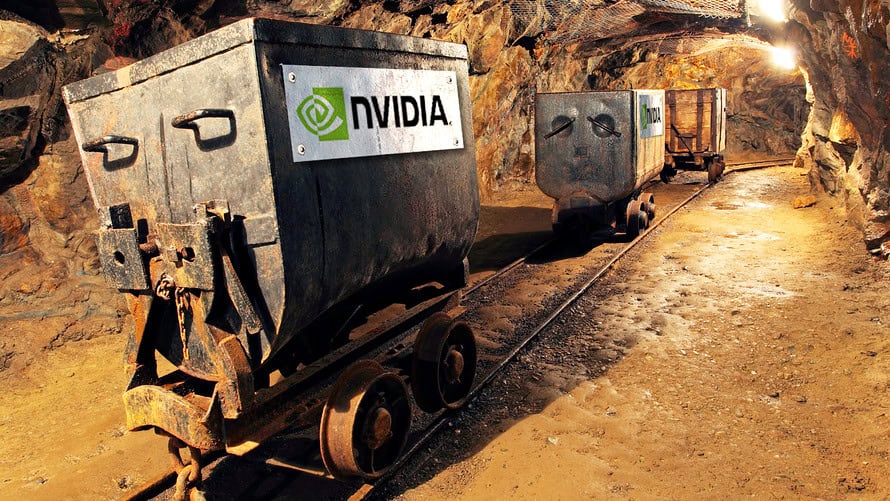
After Nvidia earnings show ‘crypto hangover,’ analysts slash price targets en masse
Nvidia Corp.’s stock plummeted Friday for its worst one-day drop in more than a decade, as a disappointing earnings report cost the graphics-chip specialist more than $23 billion in market capitalization.
Nvidia NVDA, -18.76% shares closed down nearly 19% at $164.43 in heavy trading, and are now down 15% for the year. Shares closed at their lowest price since Sept. 8, 2017, when they finished at $163.69, and the company’s market capitalization finished the day just below $100 billion at $99.97 billion. The company’s market cap hit was worth more than its biggest rival in the graphics-processing unit business, Advanced Micro Devices Inc. AMD, -3.86% which closed Friday with a market cap of less than $21 billion.
The last time Nvidia’s stock had a worse one-day percentage drop was July 3, 2008, when shares plummeted nearly 31% after the chip maker offered a disappointing sales forecast. At the close, more than 48 million shares had changed hands compared with the 52-week average daily volume of 12.9 million shares. In comparison, the PHLX Semiconductor Index SOX, -1.17% finished down 1.2% Friday, the S&P 500 index SPX, +0.22% closed up 0.2%, and the tech-heavy Nasdaq Composite Index COMP, -0.15% closed down 0.2%. AMD shares finished down 3.9%.
Late Thursday, Nvidia’s third-quarter results and fourth-quarter outlook fell well short of Wall Street estimates because the company reported having trouble clearing inventory of its older-generation Pascal architecture gaming chips following the release of its newer Turing chip. Earlier in the quarter, Nvidia released its next-generation Turing chips for professionals and gamers.
The company blamed the inventory issue on the passing of the cryptocurrency mining craze, where miners would buy gaming chips and network them into mining rigs to generate cryptocurrencies like ether ETHUSD, +1.70% But with cryptocurrency prices nowhere near last year’s peaks and the cost to mine new coins rising, more miners have sold off their rigs, unleashing a flood of secondhand gaming chips like Nvidia’s Pascal-based chips and those made by AMD onto the market.
“The crypto hangover lasted longer than we expected and we were surprised by that, but it will pass,” Nvidia Chief Executive Jensen Huang told MarketWatch in an interview Thursday afternoon.
More than half the analysts who cover the stock slashed their price targets in response to the earnings report. By Friday morning, of the 35 analysts who cover Nvidia, 23 had overweight or buy ratings, 11 had hold ratings, and one had an underweight rating. Twenty analysts cut their price targets, bringing the average price target down to $246.71 from a pre-earnings average of $285.94.
Nvidia is forecasting fourth-quarter — the holiday season — revenue of $2.65 billion to $2.75 billion, while analysts on average had been estimating revenue of $3.4 billion. By Friday morning, analysts had adjusted their revenue expectations to an average of $2.81 billion, and the fully adjusted earnings consensus had declined to $1.49 a share from a previous estimate of $2.04 a share.
B. Riley FBR analyst Craig Ellis downgraded Nvidia to a hold from a buy and cut his price target to $190 from $240 given the inventory problems affecting sales, a slowing in data center growth, and possible headwinds with multi-quarter volatility in the SOX chip index given tariffs and the U.S.-China trade war.
“Against a broader SOX expectation for choppy multi-quarter trading with potential for a downward bias well into NVDA’s seasonally-soft F1Q, we move to the sidelines, looking for more attractive entry points or unmodeled upside catalysts to get more positive,” Ellis said.
Goldman Sachs analyst Toshiya Hari removed Nvidia from the firm’s “conviction list,” while retaining his buy rating, and gave the stock a price target of $200. Hari noted:

Susquehanna Financial Group analyst Christopher Rolland, who has a positive rating, called the inventory problem “unimaginably bad” and cut his price target to $210 from $230, noting that the pain would be short-term.
“While disappointing, the crypto-bubble is temporary, but secular growth opportunities like ray tracing and A.I. are not,” Rolland said. Ray-tracing is a way to render light and shadows more realistically in a computer-generated scene, but it needs extensive computing power to render in real time. It is a big selling point of Nvidia’s Turing chips.
Morgan Stanley analyst Joseph Moore, who has an overweight rating and cut his price target to $220 from $260, said he’d recently cut in his numbers for the quarter to account for “gaming road bumps” that ended up turning into “mountains.”
“The stock will likely not bounce back right away, given the severity of the miss post management voicing confidence throughout the quarter that the litany of cautious data points did not signal a potential problem in gaming,” Moore said.
Apart from having to clear out the inventory, J.P. Morgan analyst Harlan Sur, who has an overweight rating and trimmed his price target to $245 from $255, said not to discount the Turing chip release.
“Gaming still remains strong in other areas, as new game releases like Battlefield 5 and Final Fantasy put RTX’s ray-tracing ability on display for the first time and we believe NVIDIA is on track to grow its high-end RTX-20 series sequentially in the quarter,” Sur said.


